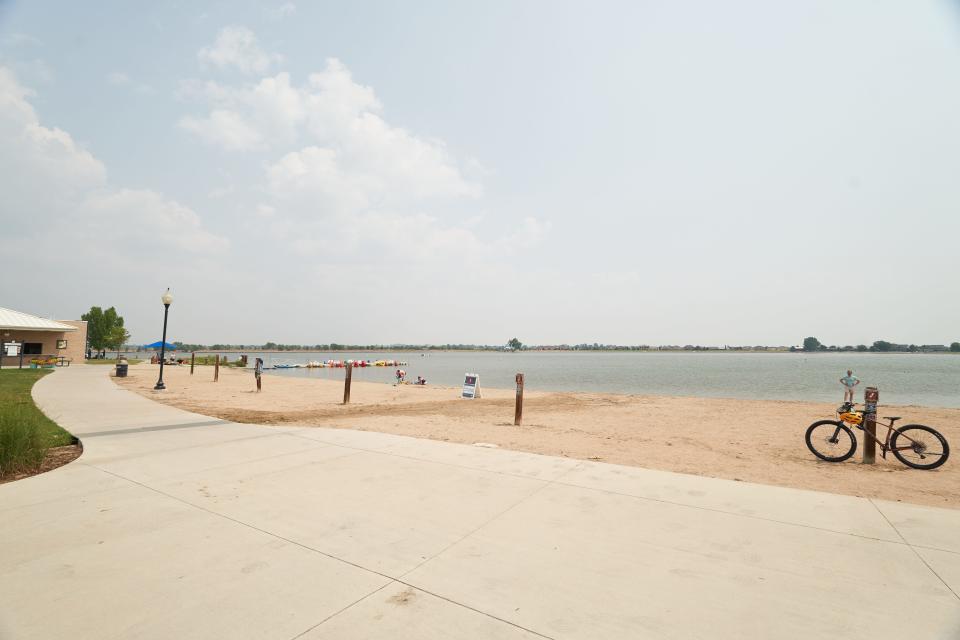How high-tech buoys are being used in Windsor to combat algae blooms
If you walked around Windsor Lake recently, you might have noticed some new, fancy-looking buoys.
In May, the Town of Windsor installed four of them for around $240,000. These special LG Sonic MPC-Buoys are a system with solar panels and sensors to control algae blooms, which can pose a serious threat for humans, pets and aquatic life.
In 2019, Windsor Lake saw its first outbreak, and since then it’s been having around one per year, Eric Lucas, the deputy town administrator told the Coloradoan.
In June, Windsor had its earliest bloom ever, Lucas noted. A week after, the lake reopened but the fun didn’t last long as a second bloom closed the lake just before Fourth of July celebrations. But once again, the lake opened a few days later with the help of the buoys.
“The theory is that, if not prevent a blue-green algae outbreak, what it should do is shorten the timeframe or the length of an outbreak, which is what we've seen,” Lucas said.
The new system works by preventing algae from getting to the surface where it can photosynthesize and grow, according to the company’s product brochure.
After one year of treatment, algae levels will significantly reduce — up to 95% compared to no treatment, according to the company.
Windsor settled on the buoys as Johnstown also implemented them, which provided a case study, Lucas said.
The company that makes them, which is based in the Netherlands, can access the data collected to learn how the system and weather here work.
“So as things are spiking, they're able to change their program to say, ‘Hey, we need to do something different,’” Lucas said.
A variety of factors play a role, but blooms occur when nutrient pollution (usually nitrogen and phosphorus) cause excessive algae growth.
This tends to happen during warmer temperatures, and along with climate change, scientists expect this trend to worsen in the future.
One of the biggest examples is in the Gulf of Mexico: Every summer when the algae dies and decomposes, it depletes oxygen in thousands of square miles — killing marine life and impacting fisheries.
One of the things Windsor has been doing is understanding where nutrients that get carried into the lake come from, Lucas said.
“Agriculture is always a big one. There's a lot of different sources, even local folks can help reduce nutrient pollution by picking up after their pets and using fertilizer responsibly, following directions on the package,” said Sarah Erickson, a water quality scientist at the Colorado Department of Public Health and Environment.
The state department, in collaboration with Colorado Parks and Wildlife and local municipalities, collects data to track blooms on an online dashboard.
Currently, 63 water bodies are monitored, the majority of which have no blooms reported.
“Sometimes, if we have the resources, if there's a local lake and they've never had a bloom before, I'll go out and help them out,” Erickson said.
As scary as they can be, not all blooms are bad.
“Algae is something that we need. Cyanobacteria, which is toxic algae, those organisms have been around since basically the dawn of time. They help produce oxygen,” Erickson said. “It becomes a problem when those warm temperatures happen, there's nutrients in the water and their population explodes.”
When this happens, the effects can be felt. Lucas said there’s no economic impact assessment from Windsor Lake yet, but “anecdotally I know there is an impact because Windsor Lake is the only free swim beach in Northern Colorado before you get to Horsetooth, so we will draw lots of people from Greeley and Eaton.”

Every year, 125,000 people walk on the lake trail, although that’s a conservative estimate — the number might be closer to 150,000, Lucas said.
“There’s no panacea out there to fix it. … We’re seeing some success, some frustration, because you invest in these technologies and you hope that we’ll never have blue-green algae again. I don’t think that’s ever the case,” Lucas said.
But there are things everyone can do to help, he added. The more work is done on the front end to prevent things getting into our water, the easier it is to deal with it downstream.
“We really are all in this together, from the top of the mountain, all the way to the ocean,” Lucas said.
Safety tips
According to the Centers for Disease Control and Prevention, you or your pet can get sick if you/they:
“Go in or near water contaminated by a harmful algal bloom
“Swallow contaminated water
“Eat contaminated shellfish or fish
“Use contaminated blue-green algae dietary supplements”
To prevent exposure, stay away from “discolored, scummy, or smelly water” and follow local guidance and advisories.
If you’ve been in contact with contaminated water, rinse off with tap water immediately.
If you have related symptoms, contact a health care provider or the Poison Control toll-free hotline at 800-222-1222.
If your pet or livestock seem sick after exposure, contact a veterinarian, the ASPCA Animal Poison Control Center at 888-426-4435 or the Pet Poison Helpline at 855-764-7661. There is a fee for these calls.
This article originally appeared on Fort Collins Coloradoan: Colorado town using technology to fight algae blooms at Windsor Lake

